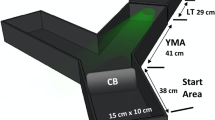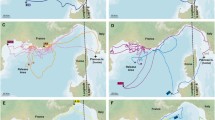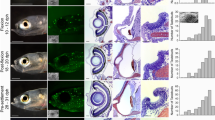Abstract
Newly hatched olive ridley sea turtles (Lepidochelys olivacea) were tested for their directional preferences in a sand-filled circular arena in total darkness. Hatchlings that had crawled about 5 m on the beach, toward the sea preferred the southwesterly direction that would have brought them to the water line, whereas hatchlings that had been denied this experience headed eastward, a direction of unclear origin. These data suggest that a short crawl across the natural beach can set the direction in which the young turtles subsequently move. The crawling experience was sufficient to acquire the compass course that they later follow, probably with the help of a magnetic compass, not only in the water, but already while still on land.


Similar content being viewed by others
References
Batschelet E (1981) Circular statistics in biology. Academic, London
Goff MD, Salmon M, Lohmann KJ (1998) Hatchling sea turtles use surface waves to establish a magnetic compass direction. Anim Behav 55:69–77
Light P, Salmon M, Lohmann KJ (1993) Geomagnetic orientation of loggerhead sea turtles: evidence of an inclination compass. J Exp Biol 182:1–10
Lohmann KJ (1991) Magnetic orientation by hatchling loggerhead sea turtles (Caretta caretta). J Exp Biol 155:37–49
Lohmann KJ, Lohmann CMF (1992) Orientation to oceanic waves by green turtle hatchlings. J Exp Biol 171:1–13
Lohmann KJ, Lohmann CMF (1993) A light-independent magnetic compass in the leatherback sea turtle. Biol Bull 185:149–151
Lohmann KJ, Lohmann CMF (1994) Acquisition of magnetic directional preference in hatchling loggerhead sea turtles. J Exp Biol 190:1–8
Lohmann KJ, Lohmann CMF (2003) Orientation mechanisms of hatchling loggerheads. In: Bolten AB, Witherington BE (eds) Loggerhead sea turtles. Smithsonian, Washington, pp 44–62
Lohmann KJ, Salmon M, Wyneken J (1990) Functional autonomy of land and sea orientation systems in sea turtle hatchlings. Biol Bull 179:214–218
Lohmann KJ, Lohmann CMF, Callaway JC (1995) Evidence that beach crawl direction sets the magnetic compass in loggerhead hatchlings. NOAA Tech Memo NMFS-SEFC 361:71
Mrosovsky N, Shettleworth SJ (1975) On the orientation circle of the leatherback turtle Dermochelys coriacea. Anim Behav 23:568–591
Salmon M, Lohmann KJ (1989) Orientation cues used by hatchling loggerheads (Caretta caretta) during their offshore migration. Ethology 83:215–228
Salmon M, Wyneken J, Fritz E, Lucas M (1992) Seafinding by hatchling sea turtles: role of brightness, silhouette and beachslope as orientation cues. Behaviour 122:56–77
Acknowledgements
We sincerely thank Randall Arauz, Director of the Sea Turtle Restoration Project, for his overall support of the practical work, Johnny Seel for his assistance in conducting the experiments and the entire staff of PRETOMA (Programa Restauracion de Tortugas Marinas) for their valuable help in collecting turtle eggs and running the hatchery. Special thanks are due to the Siemens company for their financial support and to the Ministry of the Environment of Costa Rica for permitting us to carry out the study at the beach of San Miguel
Author information
Authors and Affiliations
Corresponding author
Rights and permissions
About this article
Cite this article
Stapput, K., Wiltschko, W. The sea-finding behavior of hatchling olive ridley sea turtles, Lepidochelys olivacea, at the beach of San Miguel (Costa Rica). Naturwissenschaften 92, 250–253 (2005). https://doi.org/10.1007/s00114-005-0619-z
Received:
Accepted:
Published:
Issue Date:
DOI: https://doi.org/10.1007/s00114-005-0619-z




